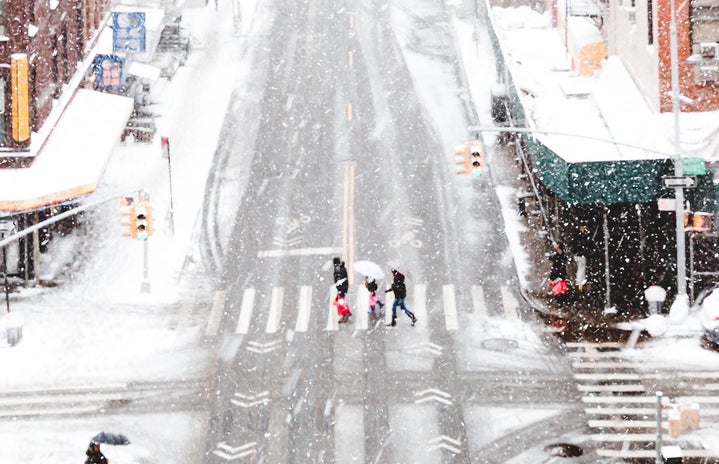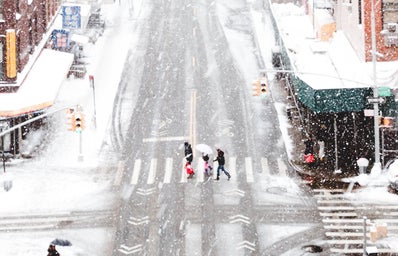Winter weather is known for striking suddenly. In last week’s article, I described how many Susquehanna students weren’t aware of an impending snow squall until it hit. The same can be said of fast-moving snow systems, blizzards, and hidden black ice.
Winter weather can be dangerous, even as we move away from meteorological winter. As the snow has been reported as late as May in Selinsgrove, here are some quick tips for managing cold weather.
Snow
It often snows between October and May in the ‘Grove. It’s common to see some flurries on-campus as the weather grows colder. That in itself isn’t caused for concern. The weather becomes dire when a larger storm rolls through or when snow is combined with ice.
If a storm is predicted to come through, take necessary precautions beforehand. Use anti-ice or salt on walkways that are prone to becoming icy and slick with snow. If you can, be sure to use pet-safe deicers, since antifreeze has been known to harm animals. In a pinch, non-clumping cat litter can work in place of a commercial deicer.
Make sure to have ample supplies on-hand before a snowstorm. This includes first-aid supplies, food, water, a battery-powered radio, deicer, pet supplies (such as food and water), and any special medications or items for sensitive parties. If you know ahead of time that a storm is coming, stock up on supplies to prevent panic-buying.
During a snowstorm, stay inside and off the roads. If you must go out, dress warmly and keep the necessary supplies in your car. After a storm, check pipes and roofs for signs of damage. When shoveling, lift with your legs and not with your back to prevent strain on your heart. If you’re not sure how to lift properly, pushing the snow or half-filling the shovel is also efficient.
Black ice
Despite its name, black ice is clear ice that forms on roads, driveways, and sidewalks. It can be especially dangerous because it’s invisible and blends in with roads, leading to accidents.
In theory, the best way to prevent black ice accidents is to avoid driving in icy conditions. Obviously, however, that isn’t feasible for many people. Black ice most commonly forms during the evenings and early mornings on poorly travelled roads, tree-covered roads, bridges, and overpasses. Avoid these areas when possible. If you must travel in an area with suspected black ice, drive slowly and cautiously.
If you do drive over a patch of black ice, the USDA recommends staying calm, keeping your steering wheel straight, shifting to low gear, and avoiding the brakes. If your car begins to swerve slightly, move the steering wheel gently in the direction your car is swerving. If you begin to spiral, lightly pump the breaks as the car swerves, aiming for a soft area to minimize the impacts on you and your vehicle.
For more information, visit the USDA website or follow the attached link: https://www.fs.usda.gov/Internet/FSE_DOCUMENTS/fseprd488148.pdf
Snow squall
A snow squall is a fast-moving intense system of snow. Snow squalls are characterized by their whiteout conditions, heavy winds, and quick formation. Snow squalls can either appear as one system or as a line of storms. The National Weather Service states that there is no safe place on a highway during a snow squall, given that whiteout conditions can occur in seconds.
If you get an alert that a snow squall is approaching, seriously consider delaying travel until the system passes. If you must go out, dress warmly and prepare for intense winds and limited visibility. If you’re driving, give yourself extra travel time and expect delays. Drive slowly and cautiously and keep your headlights on. Most importantly, don’t slam on your breaks during a snow squall, as this can lead to pile-ups and dangerous traffic conditions.
Freezing temperatures
Extreme cold can vary from region to region. In Selinsgrove, the extreme cold is 32 degrees Fahrenheit and below. The cold hurts all living things, from humans to animals and vegetation.
When you know the temperatures are set to drop, reduce travel when possible, and stay indoors. Similarly, bring all pets and sensitive plants inside. Keep a close eye on your children, pets, elderly, and neighbors. Communal support is imperative to surviving any kind of severe weather.
Check your tire pressure, heater, defroster, and water valves in the event of freeze-related damages. Keep a winter survival kit in your car (as detailed in the “Snow” section of this article).
If you must go outside, dress warmly. This includes 2+ layers of coats, 2+ layers of pants, boots, gloves, a hat, and a scarf. Protect all exposed skin from the cold as the skin can develop frostbite. In addition, familiarize yourself with the signs and treatment for hypothermia. For more information on cold-related illnesses, follow this link: https://www.cdc.gov/disasters/winter/staysafe/hypothermia.html#:~:text=What%20is%20hypothermia%3F,leads%20to%20lower%20body%20temperature.
Cold weather, like any severe weather, can be frightening, especially as a college student living alone for the first time. However, winter weather is common and adaptable. Through preparation, knowledge, and a level-head, any winter storm can be braved as winter ambles into spring.


